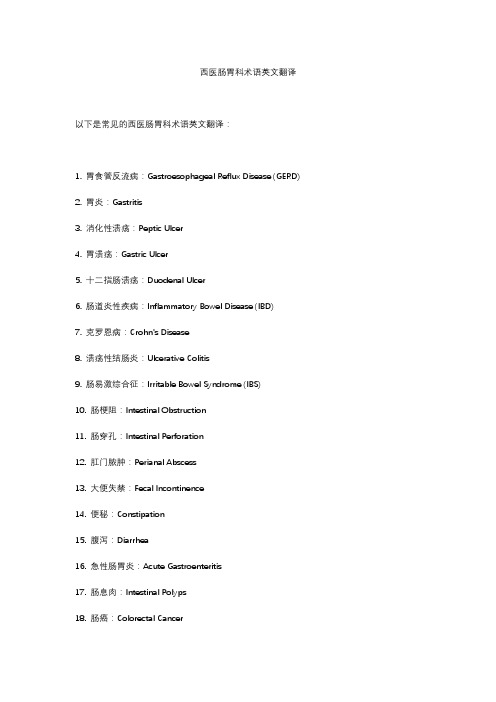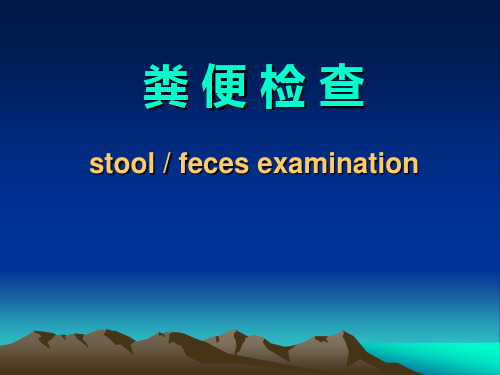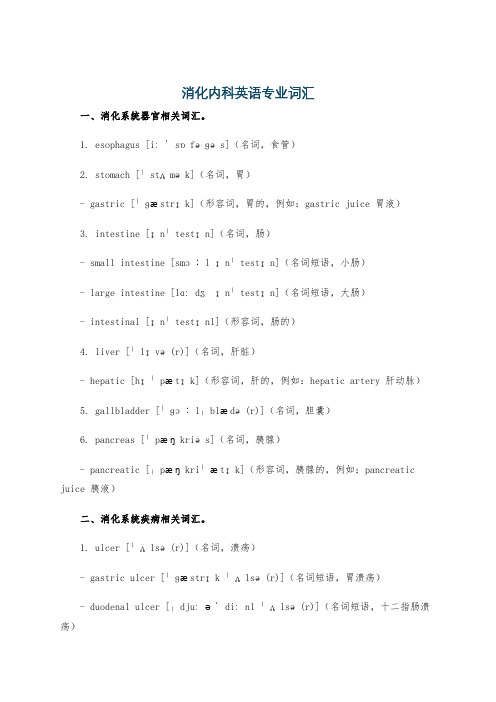stool test(粪便检查 英文)
西医肠胃科术语英文翻译

西医肠胃科术语英文翻译以下是常见的西医肠胃科术语英文翻译:1. 胃食管反流病:Gastroesophageal Reflux Disease (GERD)2. 胃炎:Gastritis3. 消化性溃疡:Peptic Ulcer4. 胃溃疡:Gastric Ulcer5. 十二指肠溃疡:Duodenal Ulcer6. 肠道炎性疾病:Inflammatory Bowel Disease (IBD)7. 克罗恩病:Crohn's Disease8. 溃疡性结肠炎:Ulcerative Colitis9. 肠易激综合征:Irritable Bowel Syndrome (IBS)10. 肠梗阻:Intestinal Obstruction11. 肠穿孔:Intestinal Perforation12. 肛门脓肿:Perianal Abscess13. 大便失禁:Fecal Incontinence14. 便秘:Constipation15. 腹泻:Diarrhea16. 急性肠胃炎:Acute Gastroenteritis17. 肠息肉:Intestinal Polyps18. 肠癌:Colorectal Cancer19. 胃镜检查:Esophagogastroduodenoscopy (EGD)20. 肠镜检查:Colonoscopy21. X线钡剂灌肠检查:Barium Enema X-ray Examination22. 大便潜血试验:Fecal Occult Blood Test (FOBT)23. 腹部平片检查:Abdominal Plain Film Examination24. 腹部CT检查:Abdominal CT Scan25. 直肠指诊:Digital Rectal Examination (DRE)26. 内窥镜超声检查:Endoscopic Ultrasonography (EUS)27. 上消化道出血:Upper Gastrointestinal Bleeding28. 下消化道出血:Lower Gastrointestinal Bleeding29. 幽门螺杆菌检测:Helicobacter Pylori Detection30. 肝功能检查:Liver Function Tests (LFTs)31. 胃肠道营养支持:Gastrointestinal Nutrition Support32. 全肠外营养支持:Total Parenteral Nutrition (TPN)33. 内镜下息肉摘除术:Endoscopic Polypectomy34. 肛周脓肿切开引流术:Perianal Abscess Incision and Drainage35. 大肠癌根治术:Radical Resection of Colorectal Cancer36. 胃肠道转流手术:Gastrointestinal Bypass Surgery37. 人工肛门括约肌成形术:Artificial Sphincter Placement Surgery38. 肠道微生物移植:Fecal Microbiota Transplantation (FMT)39. 小肠移植:Small Bowel Transplantation40. 造口术及造口护理:Stoma Surgery and Stoma Care41. 胃癌根治术:Radical Resection of Gastric Cancer42. 胰腺炎治疗:Pancreatitis Management43. 胆道疾病治疗:Biliary Tract Disease Management44. 功能性胃肠疾病的心理治疗:Psychological Therapies for Functional Gastrointestinal Disorders (FGIDs)45. 小肠镜检与治疗:Capsule Endoscopy and Therapy for Small Bowel Conditions。
粪便检查(wang)

(二)显微镜检查—手工盐水涂片镜检
• 操作方法:取一清洁玻片,滴加2滴生理盐 水,用竹签挑取粪便中的异常部份,与盐 水均匀混合制成薄涂片,盖上盖片,其涂 抹厚度以透过标本看清字迹为宜。先用低 倍观察虫卵、原虫和其它异物,再用高倍 镜仔细观察各种异常成分。细胞计数时, 至少应检查10个以上的高倍视野。
3.真菌
• 粪便中可见到的真菌有普通酵母菌、人体酵母菌 及念珠菌。 • 普通酵母菌可由于环境污染而进入肠道,也可见 于服用酵母片后;人体酵母菌为一种寄生于人体 中的真菌,正常粪便中可以见到,以上2种酵母菌 一般无临床意义,也可在腹泻的粪便中发现。 • 念珠菌,正常粪便极少见,粪便中见到此菌应首 先排除是否是容器污染而来,病理情况下以白色 念珠菌为最多见,常见于长期使用广谱抗生素、 激素、免疫抑制剂和放、化疗之后粪便中以及各 种慢性消耗性疾病。
• ( 3 )吞噬细胞( macrophage):也称大吞 噬细胞,胞质里吞噬颗粒、细胞碎片、细菌等 的单核细胞。是诊断急性细菌性痢疾的依据, 也可见于急性出血性肠炎,偶见于溃疡性结肠 炎。 • (4)上皮细胞:粪便中的上皮细胞为肠粘 膜上皮细胞,在生理情况下,少量脱落的上皮 细胞大多被破坏,正常粪便中不易发现。上皮 细胞(柱状上皮)增多可见于结肠炎、伪膜性 肠炎。 • (5)肿瘤细胞: 结肠癌、直肠癌病人的粪便 中可以见到成堆的癌细胞。
• (2)淀粉颗粒(starch granule): 正常粪便中少见,如增多,提示糖类 消化功能障碍,多见于慢性胰腺炎, 胰腺功能不全。
• (3)其他:少量的结缔组织、肌纤维、植 物纤维及植物细胞等也可见于正常粪便中。
• 5.结晶 正常粪便中可见到磷酸钙、草酸 钙、胆固醇、碳酸钙等结晶,一般无临床 意义。病理性结晶有: • ①夏科-莱登结晶(Charcot-Leyden crystal):见于阿米巴痢疾、 • 钩虫病、过敏性肠炎粪便中, • 并常与嗜酸性粒细胞同时 • 存在。
消化内科英语专业词汇

消化内科英语专业词汇一、消化系统器官相关词汇。
1. esophagus [iːˈsɒfəɡəs](名词,食管)2. stomach [ˈstʌmək](名词,胃)- gastric [ˈɡæstrɪk](形容词,胃的,例如:gastric juice 胃液)3. intestine [ɪnˈtestɪn](名词,肠)- small intestine [smɔːl ɪnˈtestɪn](名词短语,小肠)- large intestine [lɑːdʒɪnˈtestɪn](名词短语,大肠)- intestinal [ɪnˈtestɪnl](形容词,肠的)4. liver [ˈlɪvə(r)](名词,肝脏)- hepatic [hɪˈpætɪk](形容词,肝的,例如:hepatic artery 肝动脉)5. gallbladder [ˈɡɔːlˌblædə(r)](名词,胆囊)6. pancreas [ˈpæŋkriəs](名词,胰腺)- pancreatic [ˌpæŋkriˈætɪk](形容词,胰腺的,例如:pancreatic juice 胰液)二、消化系统疾病相关词汇。
1. ulcer [ˈʌlsə(r)](名词,溃疡)- gastric ulcer [ˈɡæstrɪk ˈʌlsə(r)](名词短语,胃溃疡)- duodenal ulcer [ˌdjuːəˈdiːnl ˈʌlsə(r)](名词短语,十二指肠溃疡)2. gastritis [ɡæˈstraɪtɪs](名词,胃炎)3. enteritis [ˌentəˈraɪtɪs](名词,肠炎)4. hepatitis [ˌhepəˈtaɪtɪs](名词,肝炎)- hepatitis A [ˌhepəˈtaɪtɪs eɪ](名词短语,甲型肝炎)- hepatitis B [ˌhepəˈtaɪtɪs biː](名词短语,乙型肝炎)5. cirrhosis [sɪˈrəʊsɪs](名词,肝硬化)6. pancreatitis [ˌpæŋkriəˈtaɪtɪs](名词,胰腺炎)7. cholecystitis [ˌkɒlɪsɪˈstaɪtɪs](名词,胆囊炎)三、消化内科检查相关词汇。
粪便检查

粪便检验
消化系统
•粪便(feces,stool)检查主要用于: 肠道感染性疾病 了解消化道有无炎症 肠道寄生虫感染 消化道出血鉴别与肿瘤筛检 了解胃肠道消化、吸收功能 黄疸的鉴别诊断
l 粪便标本采集和处理 标本容器 清洁、干燥、有盖,无吸水和渗漏。
标本采集 1.常规检查标本 选取新鲜标本异常成分粪便:含粘 液、脓、血等病变成分的标本。 粪便标本应避免混有尿液、消毒剂 及污水等杂物。
(2)隐孢子虫:隐孢子虫病的诊断主要 靠从粪便中查出该虫卵囊。 可用IFA、ELISA等方法作干重的1/3,大部分为正常菌群。 成人:大肠埃希菌、厌氧杆菌、肠球菌等, 约占80%。产气杆菌、变形杆菌、绿脓杆 菌等多为过路菌,不超过l0%。 婴儿:双歧杆菌、拟杆菌、葡萄球菌和肠 杆菌等。
正常粪便球菌(G+)和杆菌(G-)比例大致 为1∶10。 肠道菌群失调症(dysbacteriosis): 长期使用广谱抗生素 免疫抑制剂 慢性消耗性疾病
l 食物残渣 脂肪 用苏丹Ⅲ染色(Sudan Ⅲ stain)可 将粪便中的脂肪区分成3种。 1.中性脂肪:朱红色或橘红色。 2.游离脂肪酸 呈片状的为橘黄色、针 束状结晶不染色。 3.结合脂肪酸 呈黄色不规则块状或片 状,不被苏丹Ⅲ染色。
正常成人摄入的脂肪95%以上被吸收 脂肪泻(脂肪排泄量>6g/d):急、慢性 胰腺炎、胰头癌、吸收不良综合征、儿童 腹泻、阻塞性黄疸、蓝氏贾第鞭毛虫感染。 慢性胰腺炎。
3.鲜血便(bloody stool) 结肠癌、直肠息肉、肛裂、痔疮 4.稀糊状稀汁样便 伪膜性肠炎、艾滋病伴发肠道隐孢子虫 (cryptosporidium) 5.米泔样便 霍乱、副霍乱 6.干结便:习惯性便秘 7.乳凝块:婴儿消化不良、婴儿腹泻。
英文尴尬词

He has been unusually
He is having problem with irregularity.(或 constipation); 或 He has no bowel movement for the past few days.
解大便
一般是用 to make(或 have)a bowel movement 或 to take a shit。如果看病,医生常问:「Do you have regular bowel movement?」(大便正常吗?)(说得斯文些,就是「大肠在转动」)
此外,还有其他的说法: to defecate =to discharge excrement(或 feces)=to take feces (或 faeces)。 例如:
I have pus (或air)in urine.(尿有泡沫) (pus = cloudy; air = bubble)
I dribble a little urine after I have finished urinating.(小便后还会滴滴答答。)(即失禁毛病)
I am passing less urine than usual.(小便的量比平时少)
补充:He got pissed on head 他很生气。(想想别人在你头上撒尿是啥感觉?哈哈)
Pee or poo ? 拉屎还是尿尿?这个也是个习惯用语啊:)
(发帖时间:2002-11-7 22:09:12)
---暗流 J
回复(1):好帖……
He pissed me off. = He made me angry.
三大常规-粪便检查

7.隐血试验化学法 素食三天,禁服VitC及铁剂等干扰试验的 药品
第二节 粪便理学检验
一、量 二、性状 三、颜色 四、气味 五、寄生虫 六、结石
一、量
粪便量的多少与人体的进食量、食物的种 类及消化器官的功能状态有直接的关系。
进食粗粮及含纤维素较多的食物:粪便量相对 较多;反之,则相对较少。
第四节 粪便显微镜检查
一、细胞 二、食物残渣 三、结晶 四、病原生物 五、粪便分析工作站
最常用的方法:生理盐水涂片法
镜检方法:
低倍镜浏览全片:注意观察有无寄生虫卵、原 虫及其包囊等
高倍镜:寻找、观察和鉴定病理性成分的形态 结构。要观察10个以上的高倍视野
一、细胞
1、白细胞 2、红细胞 3、巨噬细胞 4、肠黏液上皮细胞 5、肿瘤细胞
第五节 临床应用
1、肠道感染性疾病:肠炎、细菌性痢疾、阿米巴 痢疾、霍乱、假膜性肠炎、肠伤寒等;
2、肠道寄生虫病:蛔虫病、钩虫病、鞭虫病、蛲 虫病、姜片虫病、绦虫病、血吸虫病等;
3、消化吸收功能过筛试验 4、消化道肿瘤过筛试验 5、黄疸的鉴别诊断
水分吸收过多
力者和儿童巨结肠症
黏液便
鲜血便
脓便及 脓血便
肠道受刺激、炎症或 各种肠炎、细菌性痢疾、阿米巴痢
过敏反应
疾和急性血吸虫病等
下消化道出血
肛裂、痔疮、直肠息肉、直肠癌及 结肠癌等
炎症,寄生虫感染 恶性肿瘤
细菌性痢疾、阿米巴痢疾、溃疡性 结肠炎、局限性肠炎、肠结核、结 肠癌或直肠癌和急性血吸虫病
粪便检查
the examination of feces/stool
粪便组成
¾ 是水 ¼ 是固体
粪便检查

5. Clay color stool:
obstructive jaundice, presence of barium sulfate.
6. Narrow ribbon-like stool:
stricture rectum : rectum cancer.
Chemical examination
STOOL ROUTINE TEST
feces are composed of:
Waste residue of indigested material in food Intestinal secretions, including mucus Large numbers of bacteria(1/3)
clinical significance
to diagnose slight bleeding in GIT : GIT bleeding , intestinal TB , ulcerative colitis , colon & rectum cancer , colon polyps , gastric carcinoma , GIT tumor, damaged gastric mucosa
3. Reddish stool (red color):
Bleeding from lower gastro-intestinal tract : rectum cancer, rectum polyps, hemorrhoids 4. Black-tarry stool: Bleeding in the upper gastro-intestinal tract
Stool routine test
Physical examinacroscopic examination
粪便隐血试验(OBT)及临床意义

粪便隐血试验(OBT)及临床意义一、概述粪(大)便隐血是指上消化道出血小于5 ml,粪便中无可见的血液,且红细胞被消化破坏,显微镜检查不能发现红细胞的微量出血。
检查粪便隐血采用粪便隐血试验(occult blood test,OBT)。
二、检测方法目前,粪便隐血试验常用化学法或免疫法测定类中血红蛋白,也可联合测定类中转铁蛋白。
其中,免疫法粪便隐血试验是一种高灵敏度的测定方法,有胶乳凝集法、EIA 法、胶体金法和免疫层析法等。
此外,还有半自动、全自动的粪便隐血试验仪器。
化学法一、原理血红蛋白中的亚铁血红素有类似过氧化物酶的活性,能催化H202作为电子受体使色原(如邻联甲苯胺)氧化而显色(如邻联甲苯胺氧化成邻甲偶氨苯显蓝色)。
二、试剂1、10g/L邻联甲苯胺冰醋酸溶液2、3%过氧化氢液。
三、操作1、用小木棍挑取少量粪便,涂在消毒棉签或白瓷板上。
2、滴加10g/L邻联甲苯胺冰醋酸溶液2~3滴于粪便上。
3、滴加3%过氧化氢液2~3滴。
4、立即观察结果,在2分钟内显蓝色为阳性。
四、结果判定1、阴性:加人试剂2分钟后仍不显色。
2、阳性+:加人试剂10秒后,由浅蓝色渐变蓝色。
3、阳性2+:加人试剂后初显浅蓝褐色,逐渐呈明显蓝褐色。
4、阳性3+:加人试剂后立即呈现蓝褐色。
5、阳性4+:加入试剂后立即呈现蓝黑褐色。
五、注意事项1、3%过氧化氢液易变质失效,须进行阳性对照试验,将过氧化氢滴在血片上,应产生大量泡沫。
2、齿龈出血、鼻出血、月经血等可导致阳性反应。
3、用具应加热处理(如试管、玻片、滴管等)以破坏污染的过氧化物酶。
4、也可选用中等敏感(0.3~1mg Hb/g粪便)的愈创木酯法,但必须选购质量优良的愈创木酯,配制成20g/L愈创木酯乙醇溶液,代替10g/L邻联甲苯胺冰醋酸溶液,操作同上。
免疫法一、原理采用抗人血红蛋白的单克隆抗体或多克隆抗体,与粪便样品中的人血红蛋白特异性结合以检测类便中有无血液。
本试验不受动物血红蛋白的干扰,试验前不须禁食肉类。
- 1、下载文档前请自行甄别文档内容的完整性,平台不提供额外的编辑、内容补充、找答案等附加服务。
- 2、"仅部分预览"的文档,不可在线预览部分如存在完整性等问题,可反馈申请退款(可完整预览的文档不适用该条件!)。
- 3、如文档侵犯您的权益,请联系客服反馈,我们会尽快为您处理(人工客服工作时间:9:00-18:30)。
Stool color
Normal value: Brown Clinical implication: 1. Yellow to yellow-green : severe diarrhea 2. Green : severe diarrhea Black: resulting from bleeding into the upper gastrointestinal tract (>100 ml blood) 3. Tan or Clay colored : blockage of the common bile duct. 4. Pale greasy acholic (no bile secretion) stool found in pancreatic insufficiency.
Chemical examination Water pH Occult blood Urobilinogen Porphyrins Nitrogen Normal values Up to 75 % 6.5-7.5 Negative 50-300 g/24hr Coporphyrins:400-1200g/24hr Uroporphyrins:10-40 mg/24hr <2.5 g/24hr
Clinical Implications
C. ”Pasty” stool is associated with a high fat content in the stool:
1. A significant increase of fat is usually detected on gross examination
2. With common bile duct obstruction, the fat gives the stool a putty- like appearance.
3. In cystic fibrosis, the increase of neutral fat gives a greasy, “butter stool” appearance.
Consistency Size and shape Gross blood,Mucous,Pus, Parasites
Normal values in stool analysis
Microscopic examination
Fat (Colorless, neutral fat (18%) and fatty acid crystals and soaps)
2. Bile pigments and salts 3. Intestinal secretions, including mucus
4. Leukocytes that migrate from the bloodstream 5. Epithelial cells that have been shade 6. Bacteria and Inorganic material(10-20%) chiefly calcium and phosphates. Undigested and unabsorbed food.
Stool pH
Normal value: Neutral to acid or alkaline Clinical implication 1. Increased pH ( alkaline) a. protein break down b. Villous adenoma c.Colitis d.Antibiotic use 2. Decreased pH ( acid) a. Carbohydrate malabsorption b. Fat malabsorption c. Disaccharidase deficiency
Random Collection
1. 2. 3. 4. 5. Universal precaution Collect stool in a dry,clean container uncontaminated with urine or other body secretions, such as menstrual blood Collect the stool with a clean tongue blade or similar object. Deliver immediately after collection
Interfering factors
1. Patients receiving tetracyclines, anti-diarrheal drugs, barium, bismuth, oil, iron , or magnesium may not yield accurate results. 2. Bismuth found in toilet tissue interferes with the results. 3. Do not collect stool from the toilet bowl.A clean, dry bedpan is the best. 4. Lifestyle, personal habbits, environments may interfere with proper sample procurement.
Normal values in stool Analysis
Macroscopic examination
Amount Colour Odour
Normal value
100-200 g / day Brown Varies with pH of stool and depend on bacterial fermentation Plastic, not unusual to see fiber, vegetable skins. Formed None
Ova and parasites collection
1. Warm stools are best for detecting ova or parasites. Do not refrigerate specimen for ova or parasites. 2. If the stool should be collect in 10 % formalin or PVA fixative, storage temperature is not critical. 3. Because of the cyclic life cycle of parasites, three separate random stool specimens are recommended.
Normal values
Undigested food
Meat fibers, Starch, Trypsin Eggs and segments of parasites Yeasts Leukocytes
None to small amount
None None None None
Normal values in stool analysis
Chemical examination
Chloride Potassium Lipids ( fatty acid)
Normal values
2.5-3.9 mEq / 24 hr 15.7-20.7 mEq /24 hr 0-6 g / 24 hr
Clinical Implications
1.Fecal consistency may be altered in various disease states
present in greater amounts in normal children. Osmolarity used 200-250 mOsm with serum osmolarity to calculate osmotic gap Sodium 5.8-9.8 mEq / 24hr
Normal values in stool Analysis
Stool Odor
Normal value: Varies with pH of stool and diet. Indole and sketole are the substances that produce normal odor formed by intestinal bacteria putrefaction and fermentation. Clinical implication A foul odor is caused by degradation of undigested protein. A foul odor is produced by excessive carbohydrate ingestion. A sickly sweet odor is produced by volatile fatty acids and undigested lactose
Enteric pathogen collection
1. Some coliform bacilli produce antibiotic substances that destroy enteric pathogen. Refrigerate specimen immediately. 2.A diarrheal stool will usually give accurate results. 3.A freshly passed stool is the specimen of choice. 4. Stool specimen should be collected before antibiotic therapy, or as early in the course of the disease. 5. If blood or mucous is present, it should be included in the specimen
